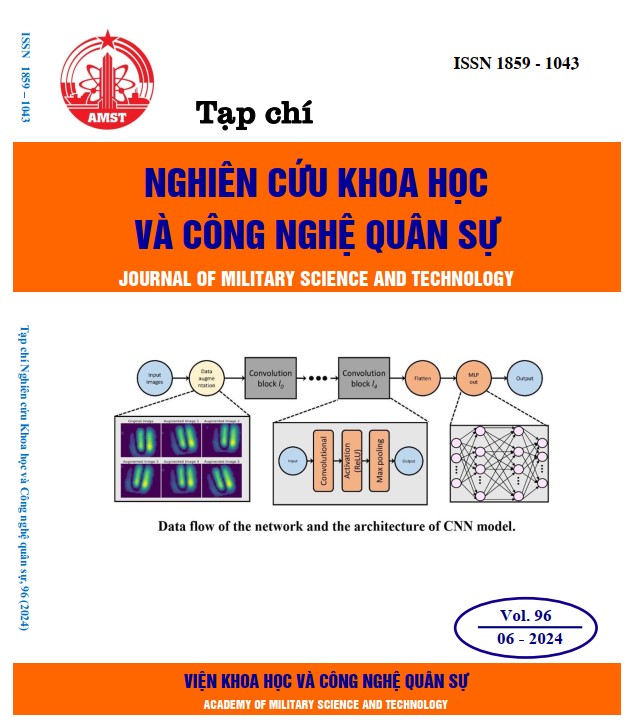Secrecy performance analysis of a IRS-assisted underwater optical wireless communication system
604 viewsDOI:
https://doi.org/10.54939/1859-1043.j.mst.96.2024.21-29Keywords:
Physical layer security (PLS); Underwater Optical Wireless Communication (UOWC); IRS-Assisted UOWC system; Intelligent Reflecting Surface (IRS).Abstract
In response to the dearth of radio frequency (RF) equivalents, there has been a recent surge in interest in optical wireless communication in underwater environments. To ensure a strong line-of-sight (LOS) connection, the intelligent reflecting surface (IRS) is installed to create a virtual LOS. Then, the first part of this study looks into the security of underwater optical wireless communication (UOWC) in relation to a number of real-world phenomena, including oceanic propagation loss, oceanic turbulence, and IRS-induced geometric loss. Then, a wiretap channel with three authorized users - a reputable broadcaster named Alice (the submarine), a law-abiding user named Bob, and an eavesdropper named Eve - is examined over turbulent channels that exhibit the Log-normal distribution. Furthermore, our study derives the closed-form formulas for the secrecy performance measures, secrecy outage probability, and secrecy throughput. Finally, the numerical results show how the impact of oceanic turbulence-induced fading and distance between Bob’s and Eve’s positions on the secrecy system performance.
References
[1]. Hassan, W., Sabril, M.S., Jasman, F, “Experimental study of light wave propagation for underwater optical wireless communication (UOWC),” J. Commun. 17(1), 23–29, (2022). DOI: https://doi.org/10.12720/jcm.17.1.23-29
[2]. Lian, J., Gao, Y., Wu, P., et al.: “Orthogonal frequency division multiplexing techniques comparison for underwater optical wireless communication systems,” Sensors 19(1), 160–179, (2019). DOI: https://doi.org/10.3390/s19010160
[3]. M. F. Ali, D. N. K. Jayakody, and Y. Li, “Recent trends in underwater visible light communication (uvlc) systems,” IEEE Access, vol. 10, pp. 22169–22225, (2022). DOI: https://doi.org/10.1109/ACCESS.2022.3150093
[4]. R. P. Naik and W.-Y. Chung, “Evaluation of reconfigurable intelligent surface-assisted underwater wireless optical communication system,” Journal of Lightwave Technology, vol. 40, no. 13, pp. 4257–4267, (2022). DOI: https://doi.org/10.1109/JLT.2022.3162627
[5]. Tuan-Lam Vu, Trung-Anh Do, Thang. V. Nguyen, Tien-Sy Dang, and Ngoc T. Dang, “Outage Performance of IRS-Assisted Underwater Optical Wireless Communication Systems over Combined Channel Model,” In the Proc. of the IEEE 19th International Conference on Wireless and Mobile Computing, Networking and Communications (WiMob), Montreal, Canada, pp. 318-323, (2023).
[6]. Meiwei Kong, Jiongliang Wang, Yifei Chen, Tariq Ali, Rohail Sarwar, Yang Qiu, Shilian Wang, Jun Han, and Jing Xu, “Security weaknesses of underwater wireless optical communication,” Opt. Express 25, 21509-21518, (2017). DOI: https://doi.org/10.1364/OE.25.021509
[7]. M. C. Domingo, “Securing underwater wireless communication Networks,” in IEEE Wireless Communications, vol. 18, no. 1, pp. 22-28, (2011). DOI: https://doi.org/10.1109/MWC.2011.5714022
[8]. Waqas Aman and Saif Al-Kuwari and Ambrish Kumar and Muhammad Mahboob Ur Rahman and Muhammad Muzzammil, “Underwater and Air-Water Wireless Communication: State-of-the-art, Channel Characteristics, Security, and Open Problems,” arXiv, (2022). DOI: https://doi.org/10.36227/techrxiv.19242624.v1
[9]. Kasture, Suraj S. and Nikhil Gudpelliwar. “Securing Underwater Wireless Communication Networks-Literature Review,” International Journal of Scientific & Engineering Research, Volume 4, Issue 12, (2013).
[10]. M. Elamassie, S. M. Sait and M. Uysal, “Effect of Sea Waves on Vertical Underwater Visible Light Communication Links,” in IEEE Journal of Oceanic Engineering, vol. 48, no. 2, pp. 515-525, (2023). DOI: https://doi.org/10.1109/JOE.2022.3211286
[11]. I. C. Ijeh, M. A. Khalighi, M. Elamassie, S. Hranilovic and M. Uysal, “Outage probability analysis of a vertical underwater wireless optical link subject to oceanic turbulence and pointing errors,” in Journal of Optical Communications and Networking, vol. 14, no. 6, pp. 439-453, (2022). DOI: https://doi.org/10.1364/JOCN.454191
[12]. A. Huang, L. Tao, C. Wang, and L. Zhang, “Error performance of underwater wireless optical communications with spatial diversity under turbulence channels,” Appl. Opt., vol. 57, pp. 7600–7608, (2018). DOI: https://doi.org/10.1364/AO.57.007600







